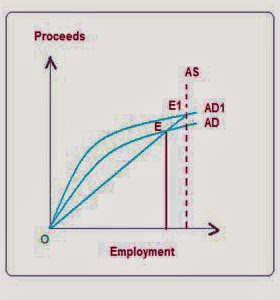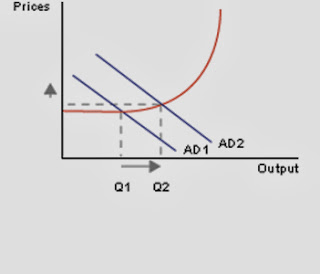Deficit
financing is practised whenever government expenditure exceeds government
receipts from the public such as taxes, fees, and borrowings from the
public. Such an excess of government expenditure can be financed
either by drawing down the cash balances of the government or by borrowing from
the central bank.
Deficit
financing as an income generating expenditure has two aspects:
- Pump
priming: Pump priming means the power of deficit
financing in stimulating private investment through giving small doses of
investment in the economy.
- Compensatory
spending: Compensatory spending means that deficit
financing can be used for compensating and neutralising tendencies towards
over-saving and under-investment.
- Deficit
budgeting refers to the situation when current expenditure exceeds current
revenue. In this situation no item on capital account is taken
into consideration.
- On the
other hand, when we take into consideration not only current receipts but
also receipts on capital account, e.g., public borrowing, and the gap
between receipts and expenditure is covered by deficit financing.
- For
prosecuting a war: During the state of war, the
government has to finance the purchase of arms and ammunitions through
deficit financing. Deficit financing during war is very
injurious for the economy. Private investments and savings are
at their worst level.
- For
fighting depression: Deficit financing can be really helpful for
the government during the period of depression. It can
stimulate private consumption and investment. The government
can increase its own expenditure on public works programme. The
government’s tax revenue remains constant but its expenditure has gone up,
therefore, the deficit has to be met by borrowings. In this
case, as government investment rises, the level of national income and
employment also increases by more than the proportionate increase in
government investment. Deficit financing can be used to create
additional employment, when the economy is suffering from a deficiency of
effective demand.
- For
financing economic development: The economic problems
faced by underdeveloped countries are different from that of advanced
countries. In advanced countries, the task of capital formation
is in the hands of private entrepreneurs but in poor countries there is a
dearth of people willing and able to undertake entrepreneurial
functions. Therefore, it is the government’s responsibility to
boost up investment in public sector, generate revenue from it and
encourage people to save and invest. But, in a country, where a
majority of people are living at the subsistence level, the margin between
income and consumption is very low so that the voluntary savings cannot
provide sufficient resources for development. The government
may attempt to increase the volume of resources by additional
taxes. Because of extreme poverty of the great mass of the people,
additional taxation beyond a point raises problems, both economical and
political.
- Increase
in the money supply with the public
- Rise in
the level of income, and
- Rise in
the general price level.
The
inflationary implications of deficit-financing is divided into two parts:
- Inflation
in a full-employment economy, and
- Inflation
in an under-developed country or less than full-employment economy.
- The
first part is related to the inflationary impacts of deficit financing in
a full employment economy. In this regard some writers hold the view
that even under the conditions of full employment, in the long run, there
is no problem of inflation, particularly in economically advanced
countries. However, infact, at full employment a further increase
in aggregate demand through deficit financing results in raising the
general price level instead of adding to aggregate output and employment.
- In the
second part, there are five reasons by which the deficit financing results
into inflation:
(a) When there is a variety of
channels into which increased money supply can flow
(b) Non-homogeneity in skills or
efficiency
(c) Supply of resources is
perfectly inelastic
(d) Increase in wage rates
(e) Increasing marginal cost
- Deficit
financing should be used in moderate doses
- Constant
watch on price index
- Prices
of consumer goods and essential raw materials should be effectively
controlled
- Ensure
a corresponding increase in the availability of goods
- Concentrate
on quick yielding projects
- In
order to keep down the prices of food grains, food imports should be
arranged well in time and in adequate quantities.
- Rise in
wages and salaries should be checked lest the country be caught in a
vicious circle of poverty
- Excess
money supply should be mapped up through taxation and borrowings
- Ensure
clean and efficient administrative system tackling the difficult economic
situation with whole hearted cooperation from the people
- Proper
disinflationary fiscal policy,
- Restrictive
monetary policy to control non-essential private investment,
- Economic
controls through selective credit control, physical and fiscal controls,
in order to influence the behaviour of private investment and channelise
it into desirable lines,
- Proper
allocation of resources with major focus on agriculture and small and
medium scale industries, and
- Developing
import surpluses for increasing the supply of goods.
Fiscal
policy with respect to inflation includes all the measures of a monetary nature
which the executive branch of the government adopts in connection with:
(a) Government spending
(b) Taxes, and
(c) Public borrowing
Fiscal
policy has come to be recognised as the potentially most powerful instrument of
economic stabilisation.
(a) Government spending: During inflation the government is
supposed to decrease its own spending to counteract an increase in private
spending. The government must simultaneously reduce expenditures and
increase revenues to achieve a cash surplus to be used in an anti-inflationary
manner.
(b) Taxes: It is axiomatic that during inflation the
existing tax structure should be retained, that tax cuts should be resisted,
and the new taxes should be adopted or tax rates increased, if possible – to
reduce the amount of spendable money in the hands of general
public. But care must be taken not to deflate the money incomes of
the country via taxation so much as to provoke a recession of economic
activity.
(c) Savings: Saving is a type of public borrowing which has a
deflationary effect on the money supply and effective demand. The
most effective anti-inflationary public borrowing takes the form of compulsory
saving.
(d) Debt Management: Public debt may be managed in such a way as to
reduce the money supply or to prevent further credit
expansion. Anti-inflation debt management often refers to the
retirement of bank-hold debt out of a budgetary surplus. It includes
the retirement of public debts of the following categories:
(i) Retirement of
public debt by central banks out of a budgetary surplus is most deflationary
(ii) Retirement of bank-held
debt (i.e., commercial banks) is neutral in its effects
(iii) Retirement of a maturing
portion of debt held by the non-bank public, which has also neutral effect.
(e) Gold Sterilisation: Whenever the gold inflow is deemed too
dangerously inflationary in effect, the government may decide to sterilise gold
in order to keep bank reserves from increasing gold acquisitions.
(f) Overvaluation: In order to control domestic inflation, a
country might maintain the overvalued exchange value of its currency, that is,
an expensive currency relative to foreign currency. An overvalued
currency is anti-inflationary in effect for three reasons, namely:
(i) Because of its
discouraging effect on exports and decreasing effect on domestic money incomes
(ii) Because of its encouraging
effect on imports and increasing effect on import expenditure
(iii) Because of its cheapening
effect on the price of those foreign materials which enter into the domestic
cost of product of its preventive effect on the upward-cost price spiral.


